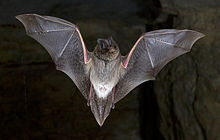Bosel and Elbe slopes north of Meissen

The 157 hectare fauna-flora-habitat area Bosel and Elbe slopes north of Meißen ( Natura 2000 area, EU registration number: DE4746303, national number: 167) is divided into two parts and is located northwest and southeast of Meißen . According to the official description of the area, these are "[s] south-west exposed steep slopes of the Elbe breakthrough valley near Meißen with rock heads, abandoned quarries and mountain-side loess plateaus, dry forests, poor grasslands and extensive [m] viticulture ".
history
In June 2002 a proposal was made to the European Commission to add the area to the list of sites of Community importance . This resulted in confirmation in December 2004. The area has been designated a Special Conservation Area (BEG) since April 2011 .
location
The FFH area is located in the Großenhainer Pflege natural area and touches the SPA area (Special Protection Area) Elbe Valley between Schöna and Mühlberg. Cities and municipalities in the area are Meißen, Coswig and Diera-Zehren . The area is located in the forest growth area Westlausitzer Platte and Elbe Valley Zone.
description
The area mainly consists of anthropogenic special areas (numerous quarries parallel to the Elbe ), mixed deciduous forest, economic grassland as well as green and open spaces. The “diverse mosaic of the most varied dry biotopes and rare habitat types, habitat for numerous rare and endangered, heat-loving animal and plant species, hermit occurrences” deserves protection.
The FFH area consists of five individual areas (listed from west to east):
- Elbe slopes near Zadel : Starts between the Hungerberg north of Kleinzadel , leads over the slopes south of Zadel and ends about 100 meters before the road between Diera and the Karpfenschänke . Many abandoned quarries on the partly wooded slope of the Elbe belong to this individual area.
- Knorrgrund and Heiliger Grund : This sub-area mainly comprises wooded slopes of the Knorrgrund and the Heiligen Grund near Proschwitz as well as the mostly very steep and rocky slope of the Elbe, which connects the two reasons.
- Römische Bosel : Consists of the predominantly wooded mountain Römische Bosel in the Spaargebirge southeast of Meißen.
- Deutsche Bosel : This sub-area is also located in the Spaar Mountains. These include the mountain Deutsche Bosel (with forest areas and vineyards), the Boselgarten belonging to the Technical University of Dresden and the steep, rocky Boselspitze.
- Elbe slopes near Karpfenschänke : Elbe slope interspersed with many old quarries above the Karpfenschänke to the Knorre, a granite rock massif that once protruded far into the Elbe like a barrier for shipping.
Eight habitat types are reported in the area:
- 6110 Basophilic Pioneer Lawn
- 6210 dry lime grass
- 6510 lowland hay meadows
- 7220 tufa -Sources
- 8230 Silicate rock tops with pioneer vegetation
- 91E0 Alder , ash and softwood alluvial forests
- 9170 Bedstraw - oak and hornbeam forests
- 9180 Gorge and slope mixed forests
Due to their rarity in Saxony, the dry lime lawns, tufa springs and basophilic pioneer lawns bound to substrates rich in lime or bases are of particular importance . The latter are best developed in the area around the Knorre. The most distinctive dry lime lawn is along the Rottewitz quarries. Tufa springs occur in only five other FFH areas in Saxony, and the spring in the area is one of the best-developed tufa springs in the Free State.
The height of the area is between Elbe level and altitudes of about 100 meters in the quarry floors near Kleinzadel to 182 meters on the Boselspitze.
Flora and fauna
The FFH area Bosel and Elbe slopes north of Meißen is a habitat for, among other things, the pug bat , the great mouse-eared bat , the blue-lipped sedum , the hermit and the Russian bear . Plants of nationwide significance include the Blue Green bedstraw , the Schönastmoos that pulsatilla pratensis , the Blue lettuce and Upright Ziest .
geology
The basement of the FFH area belongs to the Meißner granite- syenite massif, whereby the biotite - granodiorite is the most widespread type of granite. The massif is covered by a layer of loess from the Pleistocene , which has been preserved up to 15 meters thick, especially on the plateaus.
The main soil form of the area is loess- parabraunerde , partly loess- Rendzina , towards the Elbe clearly influenced by groundwater. The soil types change to Gley , Amphigley, Vega and Vegagley.
In the north-westerly direction of flow, the Elbe cut deep into the basement and created the very distinctive breakthrough valley near Meißen, which limits the Dresden Elbe valley expansion to the north.
Web links
- Overview map "FFH area Bosel and Elbe slopes north of Meißen" on sachsen.de, accessed on March 24, 2016 (pdf, 1.22 MB)
Individual evidence
- ↑ a b c d e f Bosel and Elbe slopes north of Meissen. Saxon State Office for Environment, Agriculture and Geology , accessed on March 24, 2016 .
- ↑ Complete area data. Saxon State Office for Environment, Agriculture and Geology, January 6, 2016, accessed on March 24, 2016 (pdf, 279 kB).
- ↑ a b c d Karin Bernhardt: Abridged version MaP 167 "Bosel and Elbe slopes north of Meißen". Saxon State Office for Environment, Agriculture and Geology, p. 1 , accessed on March 24, 2016 (pdf, 181 kB).
- ↑ Ordinance of the Dresden Regional Directorate for the determination of the area of community importance “Bosel and Elbe slopes north of Meißen”. Landesdirektion Dresden , January 17, 2011, accessed on March 24, 2016 .
- ↑ Conservation objectives of the FFH area "Bosel and Elbe slopes north of Meißen". Saxon State Office for Environment, Agriculture and Geology, accessed on March 24, 2016 (pdf, 33 kB).
Coordinates: 51 ° 10 ′ 54.1 ″ N , 13 ° 27 ′ 22 ″ E



